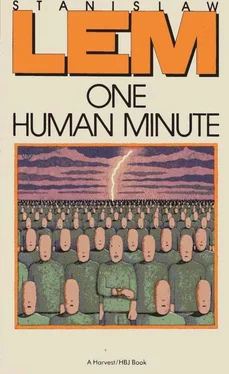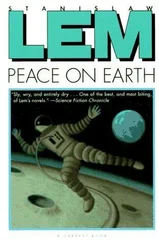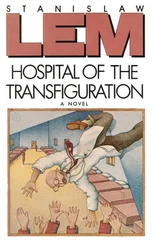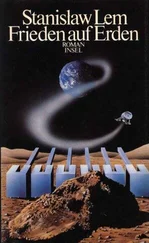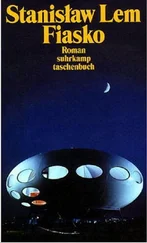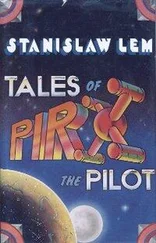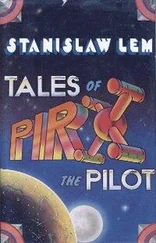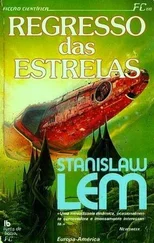The laser bomb, however, was not actually a bomb; it was a single-charge laser gun, focusing a huge part of its force into a ray that could incinerate a city (from a high orbit), for example, or a rocket base, or some other important target (such as the enemy’s satellite defense screen). At the same time, the ray would turn the laser bomb itself into flaming fragments. But we will not go into more detail about such weapons, because instead of leading to further escalation, as was expected, they really marked its end.
It is worthwhile, however, to look at the atomic arsenals of twentieth-century Earth from a historical perspective. Even in the seventies, they held enough weapons to kill every inhabitant of the planet several times over. Given this overabundance of destructive might, the specialists favored a preventive strike, or making a second strike at the enemy’s stockpiles while protecting their own. The safety of the population was important but second in priority.
In the early fifties, the Bulletin of the Atomic Scientists printed a discussion in which the fathers of the bomb, physicists like Bethe and Szilard, took part. It dealt with civil defense in the event of nuclear war. A realistic solution would have meant evacuating the cities and building gigantic underground shelters. Bethe estimated the cost of the first phase of such a project to be twenty billion dollars, though the social and psychological costs were beyond reckoning. But it soon became clear that even a “return to the cave” would not guarantee the survival of the population, because the arms race continued to yield more powerful warheads and increasingly accurate missiles. The science fiction of the day painted gloomy and nightmarish scenes in which the degenerate remnants of humanity vegetated in concrete, multilevel molehills beneath the ruins of gutted cities. Self-styled futurologists (but all futurologists were self-styled) outdid one another in extrapolating, from existing atomic arsenals, future arsenals even more frightful. One of the better known of such speculations was Herman Kahn’s Thinking about the Unthinkable, an essay on hydrogen warfare. Kahn also thought up a “doomsday machine.” An enormous nuclear charge encased in a cobalt jacket could be buried by a nation in the depths of its own territory, in order to blackmail the rest of the world with the threat of “total planetary suicide.” But no one dreamed that, with political antagonisms still persisting, the era of atomic weapons would come to an end without ushering in either world peace or world annihilation.
During the early years of the twenty-first century, theoretical physics pondered a question that was thought to be crucial for the world’s continued existence: namely, whether or not the critical mass of uranides like uranium 235 and plutonium (that is, the mass at which an initiated chain reaction causes a nuclear explosion) was an absolute constant. If the critical mass could be influenced, particularly at a great distance, there might be a chance of neutralizing all warheads. As it turned out (and the physicists of the previous century had a rough idea of this), the critical mass could change. Under certain physical conditions, an explosive charge that had been critical ceased to be critical, and therefore did not explode. But the amount of energy needed to create such conditions was far greater than the power contained in all the atomic weapons combined. These attempts to neutralize atomic weapons were unsuccessful.
In the 1990s a new type of missile, popularly called the “F&F” (Fire & Forget), made its appearance. Guided by a programmed microcomputer, the missile sought its own target after being launched. Once activated, it was truly on its own. At the same time, “unhuman” espionage came into use, at first underwater. An underwater mine, equipped with sensors and memory, could keep track of the movements of ships sailing over it, distinguish commercial vessels from military, establish their tonnage, and transmit the information in code if necessary.
Combat readiness, in the affluent nations especially, evaporated. Young men of draft age considered such time-honored phrases as Dulce et decorum est pro patria mori to be completely ridiculous.
Meanwhile, new generations of weapons were rising in price exponentially. The airplane of the First World War was made of canvas, wood, and piano wire, with a couple of machine guns; landing gear and all, it cost about as much as a good automobile. A comparable airplane of the Second World War cost as much as thirty automobiles. By the end of the century, the price of a jet interceptor or a radar-proof bomber of the “Stealth” type was in the hundreds of millions of dollars. Aircraft for the year 2000 were expected to cost a billion apiece. At this rate, it was calculated that over the next eighty years each superpower would be able to afford only twenty to twenty-five new planes. Tanks were no cheaper. And an atomic aircraft carrier, which was like an antediluvian brontosaurus under fire, cost many billions. The carrier could be sunk by a single hit from an F&F superrocket, which could split over the target into a cluster of specialized warheads, each to strike at a different nerve center of the sea leviathan.
At this same time, the production of microchips was discontinued; they were replaced by a product of the latest genetic engineering. The strain Silocobacter wieneri (named after the creator of cybernetics, Norbert Wiener) produced, in solutions containing silicates, silver, and a secret ingredient, solid-state circuits that were smaller than fly’s eggs. These elements were called “grain,” and after four years of mass production a handful of them cost no more than a handful of corn. In this way, from the intersection of two curves — the rising curve of cost for heavy weaponry and the falling curve of cost for artificial intelligence — came the “unhumanization” of the military.
Armies began to change from living to nonliving forces. Initially, the effects of the change were undramatic. It was like the automobile, whose inventors did not immediately come up with an entirely new shape but, instead, simply put an internal-combustion engine in a cart or carriage, with the harness removed. Similarly, the earliest pioneers of aviation gave their flying machines the wings of birds. Thanks to this kind of mental inertia, which in the military is considerable, not very radical new missiles, unmanned tanks, and self-propelled artillery were adapted for the new microsilicon “soldier,” simply by reducing them in size and installing computer-controlled command modules. But this was anachronistic. The new, nonliving microsoldier required a whole new approach to tactics, strategy, and, of course, to the question of what kinds of weapons he could put to best use.
This came at a time when the world was slowly recovering from two economic crises. The first was caused by the formation of the OPEC cartel and the big increases in the price of crude oil; the second, by the collapse of OPEC and the sudden drop in the price of oil. Although early nuclear-power plants were in operation, they were of no use for powering land or air vehicles. This is why the cost of heavy equipment such as troop carriers, artillery, missiles, trucks, tanks, and submarines, not to mention the cost of the newer (late-twentieth-century) types of heavy weapons, was constantly on the rise, even though by then the troop carriers had no one to transport and before long the artillery would have no one to shell.
This final phase of the military’s gigantomania in weaponry gave way to a period of microminiaturization under the banner of artificial nonintelligence. Oddly enough, it was only in 2040 that the informationists, cipher theorists, and other experts expressed surprise at how their predecessors could have been so blind for so long, struggling to create artificial intelligence. After all, for the overwhelming majority of tasks performed by people in 97.8 percent of both blue- and white-collar jobs, intelligence was not necessary. What was necessary? A command of the situation, skill, care, and enterprise. All these qualities are found in insects.
Читать дальше
